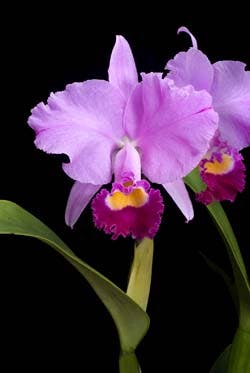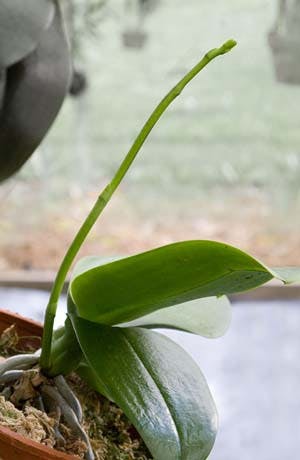
Cattleya trianae 'Mary Fennell' HCC/AOS is a good example of this winter-blooming species.
Cattleya
Watering and fertilizing will be at a minimum, as will potting. Be on the lookout for senescing sheaths on your winter-into-spring bloomers. Careful removal of the dying sheaths will still allow buds to develop without the danger of condensation-induced rot. Low light will lead to weak spikes, so, and as noted above, staking is critical. If you have a chance to get out to nurseries, there may still be a chance to acquire good plants in sheath for spring bloom. Getting them now not only ensures that you'll have them, but allows them to acclimate to your conditions and bloom at their best.
Cymbidium
We are well into the flowering season now. Outdoor growers should be cautious of freezing temperatures. Damage starts to occur below 30 F. Be diligent about tying the inflorescences for best arrangement of the flowers. Also watch closely for slugs and snails. If weather is quite wet, protect the plants from the rain and this will help to reduce the risk of botrytis spotting.
Lycaste
The most glorious of all orchids, Lycaste, will be moving toward their flowering season. Make sure the palm-like leaves do not interfere with the emerging inflorescences. Tying them loosely together often is helpful. Some growers cut the leaves off at the pseudobulb, but this removes part of the attractiveness of this elegant orchid. Resist picking up the plant to inspect those beautiful buds and then setting it down in all different directions as the flower buds will be forced to re-orient themselves to the light source each time and will not open as nicely as they should. Keep plants a little drier during the shorter days.
Odontoglossums
These cool-growing orchids once classified as Odontoglossums are now considered part of the genus Oncidium. These orchids and their intergeneric hybrids offer a great splash of color now. Though once thought of as being difficult to grow and requiring cool temperatures due to the emphasis on odontoglossum breeding, the new intergeneric hybrids made using Oncidium and Brassia, for example, are just the opposite. These plants are quite content in more intermediate conditions. New growths generally emerge in the spring, later forming beautiful plump pseudobulbs. Look for the flower spikes to emerge from the inner sheath of the pseudobulb. If your plant's pseudobulbs are shriveled, then the plants have been kept too dry or too wet. Inspect the roots to determine which condition prevailed. If the lead pseudobulb is large, plump and green (and back bulbs are shriveled) but no flower spike is evident, the plants may have been kept too dry.
Paphiopedilum
The standard Paphiopedilum insigne-derived hybrids, which are called "bull dogs" and "toads," are at their peak. Unlike most other orchids, they can even be potted while in bud. There really is no wrong time to pot a paphiopedilum, and no other orchid responds so favorably to fresh mix and a cleanup. Keep an eye on watering until roots begin to grow.

In the fall Phalaenopsis should start initiating flower spikes. Infloresences should be well developed by mid-January.
Phalaenopsis
Now is the peak of spike development, with the first plants in full flower. Staking and plant preparation is a must for those all-important spring shows. Correct staking now will give a better display and also make it much easier to transport to your society meetings and shows. Care with watering is vital to avoid mechanical damage to the flowers, as well as rot-related problems. Keep spent blooms cleaned up to avoid botrytis inoculation. Do not repot this month. Now you'll be seeing lots of phalaenopsis at orchid shows and sales.
Zygopetalum
For the most part, the flowering season will have ended for this group, providing the grower a chance to do some repotting. The plants will then have a chance to become well established before the hotter months of summer arrive. Most growers use bark mixes, but some exceptional results have been seen lately using rock-wool blends. You may want to try this mix, but do not change your whole collection over to this new media until you are sure it is right for you. First, experiment with a few plants to see how they respond.
The AOS thanks Ned Nash and James Rose for this essay.








